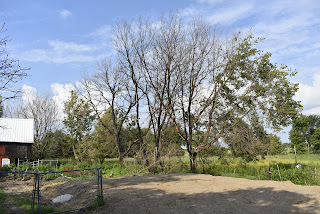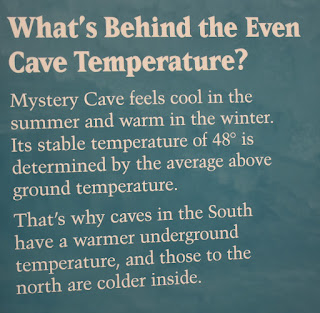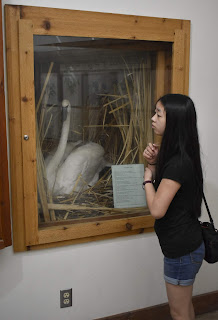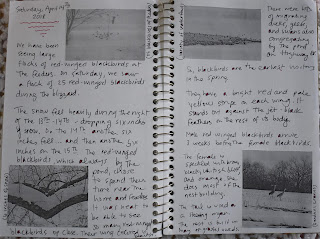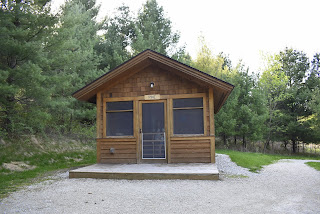During 2018, I am working towards the following goals. Some I've done in the past and others are new ones for this year. This update is for January 1-June 30, 2018:
1. Take 6 new hikes. (5 of 6 hikes taken)
It's been a frigidly-cold winter here that started out with double-digit temperatures below zero. It makes for a challenging time to be outside.
There is still beauty in the starkness of winter.
(Taken on February 16, 2018.)
During the first quarter of 2018, I've taken the dogs on our regular walks when it has been warm enough for them to be outside for a prolonged period of time. They enjoy smelling the tracks left in the snow by wildlife - like deer, turkeys, fox, and this raccoon (pictured below) that has made our farm its home.
Raccoon in the tree in the west pasture.
(Taken on March 3, 2018.)
Sophia, Olivia, and I went to Franconia Sculpture Park on March 9th. We've never trudged through the snow there as we explored the sculptures, so it felt like a new hike in the sense that we were seeing some new sculptures as well as how they looked in the snow that day.
The sun was low in the sky, so the shadows that the sculptures and weeds created on the snow were intriguing to us.
We're looking forward to going back in the spring when there's no snow to make hiking a bit easier.
*~*~*~*~*~*~*~*~*~*
On May 17th, Olivia and I were staying at Forestville State Park. Even though it was 85 degrees and we both don't do well in heat, we decided to walk a bit to explore the Historic Forestville area within the park.
There's a bridge that leads to a historic village that represents pioneer life in the 1800s. The bridge has some pretty ironwork on it.
There were chickens roaming around the village.
One log in the woodpile had an intriguing pattern.
The ferns were starting to unravel.
There were bluebells (Campanula Rotundifolia) all around us as we hiked which was beautiful. I've never seen them before so it was a treat to see fields of them in bloom.
There was a river that was by one section of the hiking trail we took.
Olivia found part of a blue eggshell on the path.
Another type of wildflower - I believe it's a Common Cinquefoil (Potentilla Simplex Michx)
was growing near the path.
There was a big tree that was hollow in the inside. Olivia could easily fit in it.
Also on the 17th,
Olivia and I went on the Hiking Club hike at Forestville State Park. The Minnesota DNR has one hike set up at each of the state parks. They give awards at the 25, 50, 75, and 100 hike marks. When also can earn a free night of camping at a state park.
We didn't know what the Hiking Club was until we came home. Nonetheless, we went on it and enjoyed the roughly one-mile hike.
There were fields of yellow wildflowers.
We crossed a bridge near the river.
Across the river was a field of bluebells.
We saw Snow Trillium (Trillium Nivale) near the hiking path.
It was a beautiful hike with many wildflowers that I have not seen before.
*~*~*~*~*~*~*~*~*~*
On May 18th, Olivia and I visited Lake Louise State Park and hiked there. This was another Hiking Club hike.
There were purple wildflowers - I think a type of wild violet - near the trail.
These two trees were completely bare - no bark whatsoever. In the distance, we heard and saw about a half dozen deer.
We reached the river which was very still. We could see the trees and clouds reflected in the water.
There was a tree stump that had holes of various sizes in it. What was unusual was that the holes were low to the ground. I've seen holes higher up on trees that woodpeckers will create, but nothing like this. The holes near the bottom are good size ones. If you look at Olivia, you can see a comparison between her and the holes in the trees.
Midway on the hike, we came across this sign with the Hiking Club password. I'm not sure what this is used for, but thought I'd take a picture in case we join the Hiking Club.
We saw a morel mushroom on the trail. There's one that is similar in appearance to the morel that is poisonous, so we didn't take it.
After a rather long hike, we came to a fork in the path. We did not have a map, so we weren't sure which way to go. Sometimes the paths can lead on for a considerable distance, and another way can lead you back to the starting point. We didn't want to risk going on and getting lost since it was in the 80s and we didn't have water with us, so we walked back the way we came.
It ended up being about a 1.8 mile walk. Once we found a map, we realized that had we taken the path to our left, we would have done a one mile walk. Oh well...we some more exercise.
At the end of the hike, we walked down to Lake Louise. Although people can swim in the lake, no one was there. The only sign of life were the deer tracks that were in the sand.
It was a pretty state park that we were happy we visited and explored.
*~*~*~*~*~*~*~*~*~*
My fifth new hike of the year was at Lake Maria State Park near Monticello, Minnesota. Sophia, Olivia, and I went on the two-mile Hiking Club hike. Within a quarter-mile into the hike, the bugs found us. We were pestered by mosquitoes and deer flies for the remaining hike which made it challenging and less-than-enjoyable.
The girls, especially, get huge swellings and reactions where mosquitoes bite them. Olivia's skin also started feeling itchy (a sensory processing disorder issue) - so our focus was simply on getting through the walk rather than taking our time and noticing things.
There was a little lake, some ponds, and secluded backpack-in campground sites. During the early-Spring and Fall, I'm sure it's beautiful since there would be no bugs. It would be worthwhile going back in the Fall when the leaves are changing colors.
2. Read 4 books about nature. (3 out of 4 books read)
I read
Flights of Fancy during January and February. I thought this was a new book that I had not read. Interestingly,
I had read this book before in March 2014. Apparently it wasn't that memorable.
There were a lot of facts about birds as they appear in myths, stories, and the Bible. However, many of the birds don't live in the United States since the book was written by a British ornithologist. The majority of the birds are European ones.
In March and early-April, I read
An Eagle Named Freedom. I enjoyed the book, and was happy that I read it.
During May, I read Never Cry Wolf by Farley Mowat. Initially, the author's writing style took a little getting used to, but within a few chapters and until the end, it was a captivating book filled with a lot of information about arctic wolves.
There was an issue back in mid-1960s with a significant loss of caribou and people were attributing it to predation by wolves. The author, a researcher/scientist who spent months living among the wolves, realized it was not, in fact, the wolves - it was humans who were going in and mass-killing the caribou.
Aerial safari/shooting sprees were being arranged so trophy hunters could go in and kill lots of caribou and pick the best heads for their walls and loins for eating. They would leave the rest of the dozens of carcasses on frozen lakes - where they were gathered and panicked by small aircraft and then shot by trophy hunters - as waste.
So, the wolves were being given a very bad name until he exposed what was actually happening. What a tragedy for the caribou and wolves. After reading this book, I have a new appreciation and understanding of wolves. It is well worth taking time to read
Never Cry Wolf.
3. Visit 2 state parks that I’ve never seen. (3 of 2 visited)
During May, Olivia and I visited Forestville State Park in the southern Minnesota. There is a historic part of the park operated by the Minnesota Historical Society. We walked around the area, but did not do the tour (which is conducted only on the weekends when we visited).
The hikes were beautiful - some parts were forested, other paths were along rivers, and all were lined with a variety of wildflowers.
Since Spring came late this year, all the wildflowers were blooming and trees blossoming at the same time - it was a particularly beautiful time of the year to visit this part of the state.
About 20 minutes away from Forestville State Park is Lake Louise State Park. I had never heard of it until visiting Forestville. It is a small park without staff (at least at the time of year we went). It sounds like Forestville and Lake Louise State Parks share staff.
At any rate, we went on the Hiking Club hike through a beautiful forested area.
We wound our way back and then walked down to Lake Louise - a rather narrow, yet long lake.
There were deer tracks in the sand - more so than human footprints - showing how many deer there were in the area and how they depended on the lake for water. While we were hiking, we did see a small herd of deer - about a half dozen - in the forest. We must have startled them for they ran off in the opposite direction, their white tails flapping as they departed.
On June 17th, the girls and I went to Lake Maria State Park. It's a little more than an hour from our home, but we've never visited it.
We went during a time where there were many mosquitoes, flies, and deerflies.
I think this park would be much more enjoyable during the early-Spring and Fall when there aren't as many insects.
4. Visit 2 nature centers that I haven’t visited before. (2 of 2 visited)
The weather was so cold this winter and spring, that the thought of going to a state park and exploring a nature center was far from my mind during the first three months of the year.
One of Sophia's photos from the car.
It was a cold day on April 3rd, and we noticed
a huge flock of ducks, geese, and swans at a small pond in a field.
Sometimes we stop on the side of the road and
take photos of the wildlife we see.
When it is cold, snowing, and/or sleeting - sometimes being in a car
is the best (and warmest) place to enjoy nature.
By May, the weather was much warmer. Olivia and I visited Mystery Cave's visitor center (part of Forestville State Park) and learned about caves through the displays there.
There was a display about Turquoise Lake - which is in Mystery Cave - and the contents of one gallon of water from it. There are many minerals that drip down into the cave and into the water, giving it its beautiful turquoise appearance.
There was a display about the wildlife that sometimes makes an appearance at the cave.
What I found interesting was that the cave's bats are counted every three years. They are not disturbed more often because it can use up to 10 to 30 day's worth of fat reserves, or enough to keep it from surviving the winter.
I also learned about how the air temperature above ground determines the cave temperature; and how caves in various parts of the county are different temperatures.
Lake Maria State Park had a small visitor center that we saw on June 17th.
There were hand-drawn and painted wildflower pictures with information about each type of flower below it. There also was a trumpeter swan that was stuffed.
5. Do 1 entry per month in my nature journal. (4 journal entries done for January and February collectively; 1 for March, 3 for April)
In January, I did two entries. One was about winter colors.
The other one I did in January was about birds I was seeing at the feeder.
During February, I did a two-page spread about turkeys in the wild.
I've been seeing lots of turkey tracks along the roads in the ditches and leading into the fields and woods near our home. This is exciting because when we first moved to the farm in 1995, the turkeys were not in our immediate area. They have slowly made their way to the area indicating that there's enough food and shelter for them.
I also did a two-page spread about eagles since we had been seeing a few of them around the area.
I still need to do entries for March. The sandhill cranes returned on March 20th.
They are such graceful and beautiful birds that migrate south each winter and return in the spring.
Their unusual call is a sure sign that spring is returning (although it sure doesn't look like in these photos).
I finally did an entry for March on the 30th. The focus was on walking the dogs and noting things I saw, the temperature, and what the dogs enjoyed.
During April, I did an entry about the unusual 18 inches of snow we received from April 13-16th.
I also printed some black and white photos off on the printer and put them in my nature journal for an entry on April 14th. Despite the huge snowfall that weekend - of perhaps because of it - we saw a lot of birds up close at the feeder and gathered around open water.
Later in the month, on April 28th, I did an entry about frogs and the types that we are seeing and hearing here at the farm.
I still need to complete entries for May and June.
6. Go on a camping trip to a new location. (1 of 1 camping trip taken)
Olivia and I camped in two camper cabins at Forestville State Park in May. The first one we stayed in was quieter and more secluded than the one we stayed in on the second night. We liked this one - Pine - better.
Olivia chose the top bunk and I chose the lower level bunk.
Despite all of our camping gear - minus sleeping bags - burning in the fire at our farm on May 5th, we still had two carts of gear for our trip. The state park provides the carts for cart-in camping which is nice. One of the carts had firewood that took up most of it, so we didn't have as much as we have in past years. We're getting to be more efficient packers (by necessity, in this case) which was nice.
The second night, we chose to eat inside the camper cabin - partly because it was hot outside and there was no shade where the picnic table was and partly because there was less privacy.
We did cook our food over the campfire which was nice. You can't go wrong with food prepared this way. It always tastes better - especially roasted marshmallows.
7. Plant on our nature trail 10 trees and shrubs that are native to Minnesota. (Do this after assessing what types of trees we have at the farm and aiming to have at least 25 different varieties after everything is planted.) (0 of 10 trees or shrubs planted)
I did not do anything with this goal. We are working on recovering after the fire, so planting trees hasn't happened yet. We had to take down 15 trees that were damaged in the fire.
This is one of the groves of trees that had to be removed. Most were boxelder trees. Lots of birds used these trees as a resting and nesting spot.
It was difficult to watch the trees come down.
It opened up the view (at least temporarily) to the west.
However, that it quite a bit of habitat loss; and I would like to see a wider variety of trees planted throughout the farm to compensate for this loss. We will have to see, though, since the costs for rebuilding and repairing for not only the fire, but the water/mudslide which resulted in the excavation of the cellar entrance and steps have far exceeded what we anticipated.
8. Attend 2 workshops, classes, or activities at state parks or community organizations. (3 of 2 workshops, classes, or activities done/taken)
During the first quarter of the year, it was too cold to do anything at the state parks. In lieu of going to a state park, Sophia, Olivia, and I went to the White Bear Center for the Arts for an outdoor celebration on January 27, 2018.
In addition to having fun on the pottery wheel and looking at the art indoors, there were dog sled rides that Olivia went on.
There were ice and snow sculptures to enjoy outdoors.
It was a fun way to spend the afternoon.
On March 3rd, we hosted a One Stop Donation Drop at the community center. There were 26 non-profit organizations represented there including the Wildlife Science Center. They brought a hawk which was interesting to see up close.
The coloring and pattern of the feathers was stunning. It was such a treat to be able to see a raptor up close.
On May 19th, Olivia and I took a tour of Mystery Cave which is part of Forestville State Park. It's actually about a five-minute or so drive away from the state park, though it is staffed by park rangers and guides.
The cave was very accessible - the floors were level and smooth.
This was an active cave with flowing water that, at times, was highlights with subtle lighting.
Some of the cave formations were darker due to the minerals (I believe it was iron) present in the water.
Some of the pathways were metal grating that provided clear views to the cave below. There were crevices that were easily 25-100 feet deep.
At the end of the tour, we saw Turquoise Lake. Although it wasn't nearly as big or bright as some of the pictures we've seen, it was the first time we saw an underground lake which was interesting.
I had hoped that we would have nice weather in March to do a picnic or two. No such luck. After a very brief "warm" spell that got to the upper 40s, the temperatures plunged back down to the single digits during the end of March and early-April.
We then had back-to-back 6" snowfalls.
One of the bird feeders covered in snow from one snowfall.
It's so important to feed the birds -
especially those newly-migrating back to the area -
who need food yet nothing is available yet in the wild.
(Taken on March 31, 2018.)
So, no picnics in this cold and snowy weather!
The first official picnic of the season was on Thursday, May 17th at Forestville State Park. Olivia and I had a simple dinner - hotdogs, chips, and roasted marshmallows by our camper cabin (Pine).
We always roast marshmallows and like them golden brown. My dad taught me to roast them once, until they are golden brown, and gently remove the outer "shell." Then, go back to the campfire and re-roast the marshmallow so the inner part gets golden brown.
On Friday, May 18th, we had a simple lunch at a gazebo in Harmony, Minnesota, before visiting many Amish farms. We had picked up a protein lunch pack at Wal-Mart before leaving on our camping trip so we had that, chips, and water.
Afterwards, we looked at the apple trees that were blossoming.
The flowers were so beautiful and fragrant.
10. Walk on 4 outdoor labyrinths. (My eventual goal is to have walked on the same number of labyrinths as my age. Obviously, I have a long way to go to reach this goal.) (0 of 4 labyrinths walked)
The majority that are close-by seem to be on grass or indoors. During the first quarter of the year, I didn't do any walks.
Sunrise on March 25, 2018.
This is looking northeast from our front yard.
During the second quarter of the year (April through June), I still didn't do any walks. I'm wondering if this is a goal that I need to let go. Perhaps it's not as important to me as it once was; and isn't critical to appreciating and enjoying nature.

